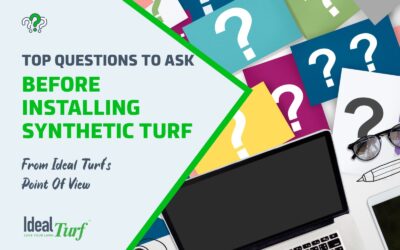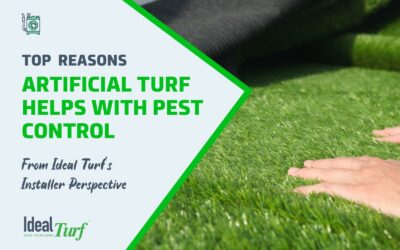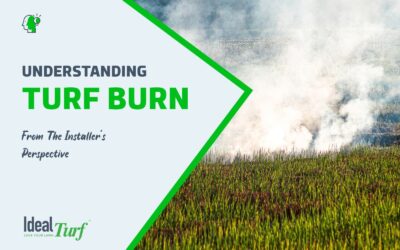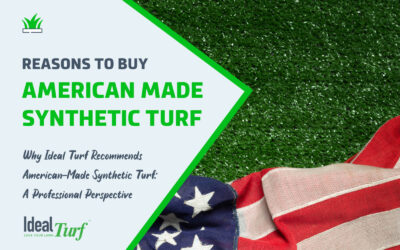Types of Infill Materials Used on Artificial Turf: Which Infills Are Best for Children & Pets?

Artificial turf, also referred to as synthetic grass, has become increasingly popular as a low-maintenance substitute for natural grass. It has grown in popularity for just about every application including residential landscapes, playgrounds, sports fields, dog parks/pet areas, and more.
An often overlooked component of artificial turf is the infill material beneath the surface. Infill, the material placed between the synthetic grass blades, is more than just a filler—it plays a crucial role in ensuring stability, durability, and safety in artificial turf installations.
From ensuring proper and efficient drainage to minimizing odors and providing cushioning, infill acts as the foundation of artificial grass systems. It helps turf installations withstand the demands of different applications.
Infill is essential for creating the realistic appearance, texture, and functionality of artificial turf. It also offers cushioning, safeguards the grass fibers, and stabilizes the surface.
However, not all infill choices are appropriate for areas where children and pets play. This article will clarify the purpose of infill and recommend the most suitable options to ensure the safety of your kids and pups.

What is Artificial Turf Infill?
Infill: noun | in·fill – “Material that fills or is used to fill a space or hole.” – Merriam Webster
Infill is the material used to fill the gaps between the blades of artificial grass. It is usually spread on top of the grass using a drop spreader, and then the turf fibers are agitated to help the infill settle in between them.
In the past, infill options were limited to sand, crumb rubber, EDPM, and TPE. However, new infill materials have been introduced in recent years. These include acrylic-coated sand, synthetic rubber, and organic options like cork, coconut, and walnut shells. Each infill material has its own unique qualities and characteristics that make it suitable for different residential and commercial turf applications.

Why Does Artificial Grass Need Infill?
Infill serves several important purposes in artificial grass installations. While not every installation requires it, infill is generally recommended for outdoor use. One of its primary functions is to add weight and stability to the turf, preventing it from shifting. It also surrounds each turf fiber to help keep it upright and reduce matting.
Infill enhances the stability underfoot, protects turf fibers from excessive wear, helps reflect heat, and contributes to a natural, lush appearance. It also enables the artificial lawn to withstand foot traffic without becoming overly compacted.
Beyond stability, infill improves the overall feel of the surface, offering a cushioning effect that closely mimics the experience of walking on natural grass. It also helps shield the turf backing from harmful UV rays, extending the life of the installation.
In a well-installed artificial turf system, infill can make up about 90% of the system’s total weight, making it the most influential factor in performance. It plays a vital role in ensuring stability, aesthetics, safety, drainage, comfort, and durability.
The turf industry has seen the emergence of more advanced infill materials in recent years. Products like Envirofill offer added features such as antimicrobial protection and enhanced temperature control, making them particularly well-suited for high-traffic and outdoor environments.
In summary, infill is a critical component of artificial grass systems, significantly impacting their performance, comfort, and longevity.
Does All Artificial Grass Need Infill?
Infill material is not necessary for all artificial grass, although it is highly recommended for most installations. In certain cases, such as decorative landscaping in low-traffic areas, infill may be optional. However, even in these situations, using infill can still offer advantages like improved stability and aesthetics.
In high-traffic areas or intense use applications like sports fields, playgrounds, and pet areas, infill becomes essential. Without it, artificial grass fibers may flatten over time, resulting in a less appealing appearance and decreased performance. Therefore, while not all artificial grass installations require infill, its use is generally recommended for best results and longevity.
How Much Infill Do I Need for Artificial Turf?
How much infill your artificial turf needs depends on a few factors:
- Turf Application
- Type of infill
- Expected foot traffic
- Type of grass
A general rule of thumb is to use enough infill such that only the top ½” to ¾” of your grass is exposed. Use the following formula to calculate the the amount of infill needed for your turf installation. First, you’ll need to know the pile height of the turf being installed and the total square footage of the project.
To begin, divide the pile height of your turf by 2, multiply it by the square footage of your project, and then multiply that by 0.0833333 to get the number of cubic feet. This number is then multiplied by the infill weight per cubic foot to determine the total weight of infill needed in pounds.
Motz Group, manufacturers of Envirofill and Safeshell infills recommend between 1.5 and 3.5 lbs. per square foot for residential applications.
| Granule Size | Turf Pile Height | Type of Turf | Infill Depth | Lbs. Per Sq. Ft. |
|---|---|---|---|---|
| 12/20 or 16/30 | 1-1¼” | Pet/Playground | ⅜” – ½” | 1.5-2.5lbs |
| 12/20 or 16/30 | 1½ – 1 ¾ | Landscape | ½” – ¾” | 2.5-3.5lbs |
| 12/20 or 16/30 | 1⅞” – 2 ¼” | Landscape | ¾” – 1” | 3.5-4.5lbs |
If you are ever unsure about the proper amount of infill required for your artificial grass installation, check with the manufacturer. You can usually find this documentation on the manufacturer’s website.

What Types of Infill Materials Are Used on Artificial Turf?
The infill material is a crucial component of artificial turf installations. With the growth of the turf industry, there has been a significant increase in the number of infill options.
Some brands now offer infill products designed for specific uses such as pets, golf, sports, and playgrounds. New features, improvements, and qualities will continue to be developed to create innovative infill products. Despite the many infill options in the turf market, there are essentially four main types of infill materials: rubber, silica sand, zeolite, and organic.
Rubber Infills
There are a few types of rubber infills that can be used for artificial turf. The two main options are crumb rubber and EPDM rubber. Crumb rubber is made from recycled tires and is a popular and cost-effective choice for infill. However, crumb rubber has a tendency to become very hot in direct sunlight. Because it’s made from recycled tires, it tends to be the infill option most often associated with potential health concerns.
EPDM (Ethylene Propylene Diene Monomer) rubber is man-made and comes in just about any color. It’s generally thought to be safer than crumb rubber. Similar to crumb rubber, EPDM rubber is highly durable and provides excellent shock absorption, making it popular for athletic fields.
Silica Sand Infills
Silica sand is the second most widely used infill material and is the least expensive. It also serves as the building block of acrylic-coated infills. Manufacturers and turf companies have created their own brand names for the same product. Some of the more popular acrylic-coated silica sand infill options are Envirofill, DuraFill, WonderFill, Hydrochill, HeroFill, MellowFill, and Putting Green Infill to name a few.
Whatever you want to call it, acrylic-coated infills are essentially manufactured sand with rounder edges. The “rounder” edges of are less prone to compacting and provide better impact absorption.
Zeolite Infills
ZeoFill is an organic infill made from volcanic ash minerals, considered the best for eliminating pet waste smells. It is generally considered the best infill to use to help eliminate pet waste smells.
Zeolite is also very porous which helps to keep your turf cooler in direct sunlight compared to most rubber or sand infill options. For this material, you should use a heavier infill, such as sand, as your base infill and then add a secondary layer of Zeolite on top.
Organic Infills
Made from natural materials that are odor-free and non-toxic, organic infill has been steadily increasing in popularity. Most organic infill products today are made from things like walnut shells, wood fiber, coconut fiber, olive pits, and rice husks.
All-natural, (usually) chemical-free, and compostable, they’re an increasingly popular choice for people who want to reduce their environmental impact — an interest that artificial turf systems already help serve.
The organic materials boast a natural resistance to mold, mildew, and decay and allow for clean water runoff. Superior foot stability and pressure distribution is safer and less abrasive for athletes. And, with 100% recyclable materials, organic infill can be repurposed in an environmentally friendly way.

What is the Best Infill Material for Children & Pets?
Selecting the appropriate infill is extremely important, especially if you have children and/or dogs. When it comes to play areas, ensuring the safety of the infill material is of utmost importance.
The type of infill used can directly impact the likelihood of abrasions, allergies, skin irritation, and even burns for children and pets who spend hours playing on the turf surface. Additionally, babies and pets are at risk of ingesting small bits of infill during play.
Therefore, it is essential to choose an infill option that is safe for children and pets. Ideally, the infill should also have properties that inhibit bacterial growth, reduce odors, and are easy to clean and maintain over time to ensure a hygienic play environment.
For the sake of simplicity, we’ll be recommending the “Best” infill material for children and pets separately. Children don’t… or shouldn’t relieve themselves on artificial turf like dogs do. Therefore the hygienic needs of pet-friendly artificial grass are a little more important.
Also, dogs are less prone to falling off of playground equipment, so kid-friendly infills need to provide better impact attenuation. The right combination of artificial grass, infill material, and shock pad will significantly improve playground safety. Below you’ll find our recommendations for the “Best” infill material for kid-friendly turf and dog-friendly turf applications.

Recommended Infill Options for Dog-Friendly Spaces
When choosing infill for their artificial grass, dog owners need to take into account factors such as drainage, odor control, and safety. Regardless of the infill type chosen, regular pet turf cleaning and maintenance is crucial to ensure a clean and hygienic surface for both pets and their owners.
The ideal infill material for your dog will depend on your specific requirements and budget. If you’re unsure about the right infill material for you, you can seek advice from a professional artificial turf installer. The following are infill products specifically designed with dogs in mind.
Envirofill
Envirofill, also known as DuraFill and WonderFill, is a top-notch infill material made up of a rounded quartz core coated with a green acrylic resin. It includes Microban® antimicrobial protection to continuously guard against the growth of bacteria, mold, and mildew.
The selection of a silica sand core is based on its uniform round shape, which enhances the product’s durability and consistent performance. Its round shape enables excellent drainage and prevents compaction, ensuring that the turf remains resilient and comfortable underfoot for an extended period.
ZeoFill (ZeoLite)
ZeoFill Infill is well-known for its natural and organic composition, which is derived from zeolite minerals. Zeolites are natural porous substances that form when volcanic rocks and ash react with groundwater. ZeoFill stands out due to its antimicrobial properties, which are a result of zeolite’s natural ability to inhibit the growth of bacteria and odors.
Zeolite is especially effective for pet areas, as it can eliminate pet urine odors and maintain a clean surface. It is not suitable to be used as the sole infill and should be combined with one of the pet-friendly infills mentioned above. The denser infill should be applied first, with ZeoFill used as a top layer for infilling.

Recommended Infill Options for Kids’ Playgrounds & Play Areas
Many different materials are used to make infills, including crumb rubber from recycled tires, sand, and thermoplastic resin pellets. We don’t recommend traditional crumb rubber infill for children’s play areas as studies have shown that this material, when overheated, can leak chemicals.
Instead, opt for non-toxic and organic infills like Envirofill and Safeshell. Remember to ensure proper installation and choose artificial turf products and infill materials that meet IPEMA safety standards.
SafeShell® Infill
Safeshell is a 100% natural, organic infill option that is safe for children. Made from walnut shells cultivated in the U.S. it is non-toxic, free from allergens, and even suitable for food use! It even helps make an artificial turf system more accessible for wheelchair users.
Another reason to choose Safeshell is that it helps to keep the surface of synthetic turf systems cool by up to 50°F. This makes it especially beneficial for playgrounds that become uncomfortably hot to touch on summer days.
Amazingly, SafeShell is completely safe for those with food or nut allergies. Motz teamed up with a leading biotech firm to develop a patent-pending process to eliminate any potential allergens that might remain on the shell after separation from the nut. The process removes allergens below 2.4 parts per million.
Coated Sand Infills
The coated sand infills we recommend for playgrounds and play areas include Envirofill. This infill is a specialized type of sand that has been treated with a flexible, non-toxic acrylic polymer. The coating serves multiple purposes, including preventing dust inhalation and reducing the risk of abrasions that can occur with regular sand.
In addition to its safety benefits, coated sand infill also offers practical advantages. It minimizes compaction, which can help maintain a softer and more cushioned surface over time. Furthermore, the coating resists bacteria and odor more effectively than untreated sand, making it particularly suitable for use in playgrounds and pet areas.
Overall, coated sand infill is an ideal choice for environments where safety, durability, and hygiene are important considerations. Its unique properties make it a valuable option for creating safe and comfortable play areas for children, as well as maintaining clean and odor-free spaces for pets.
EPDM Rubber
Ethylene Propylene Diene Monomer (EPDM) is a form of recycled rubber derived from car and truck tires. The vibrant EPDM granules are effective at absorbing shocks on playgrounds and also have excellent acoustic qualities for noise reduction.
The infill made from EPDM is non-toxic, does not contain lead, and is relatively affordable. With proper maintenance, it can last for over 15 years. It is important to obtain high-quality EPDM that is certified safe for use in children’s play areas.
TPE Infill
Thermoplastic Elastomer (TPE) infill, made from recycled post-consumer and post-industrial plastic waste, is an eco-friendly option. Its smooth texture is safe for children and offers exceptional durability and resilience. TPE also prevents bacterial growth, resists static build-up, and can withstand Texas’ fluctuating weather conditions. While more expensive than rubber, it is well-suited for use in schools, parks, and home play areas.

Key Takeaways on What Infill is & Why Artificial Grass Needs it
Infill is crucial for the effectiveness and durability of synthetic turf installations, offering stability, resilience, and safety advantages. While not all artificial grass installations necessitate infill, its usage is advisable for optimal outcomes, particularly in high-traffic areas or applications subjected to heavy use.
Selecting the appropriate type of infill is vital, depending on the particular requirements of the installation. Infill is an essential component of artificial turf systems and plays a significant role in:
- Drainage Efficiency
- Odor control
- Safety
- Appearance
- Usability
- UV Protection
- Imapct Absorbtion
- Accessibility
- And more…
Whether it’s for dog runs/pet areas or playgrounds, choosing the right infill material can greatly influence the overall performance and satisfaction of artificial grass users.
Additionally, proper maintenance practices for the turf, such as regular grooming and cleaning, are essential to ensure the longevity and functionality of artificial grass installations. By now we’ve established the importance of infill for artificial grass. Choosing the best infill for your specific needs will help to increase the benefits of artificial grass while optimizing its performance and lifespan.
If you have questions about infill or you’d like to discuss artificial turf for your home or business in Texas or Oklahoma, contact Ideal Turf. To speak with our team simply click the “GET A QUOTE” button or feel free to give us a call at (800) 276-8587.
Recent Posts
- How Synthetic Turf Helps Keep Fleas and Ticks Out of Your Texas and Oklahoma Yard
- Porches, Patios & Personality: Creating Outdoor Spaces Texans Love
- Turn Your Backyard into a Golfer’s Dream: Custom Putting Greens by Ideal Turf
- Why Texas Pet Owners Are Choosing Pet-Friendly Artificial Grass from Ideal Turf
- Why More Texans and Oklahomans Are Turning to Artificial Grass for a Greener Future






